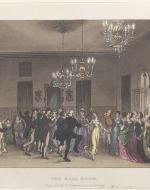Created by Abigail Smagala on Tue, 10/08/2024 - 21:35
Description:
Along with providing the dress code for assemblies, the Rules of Assembly also outlined the rules for overall behavior at assembly rooms. Public balls were highly formal. The attached image is Thomas Rowlandson’s 1813 piece simply titled “The Ball Room.” This image shows a group of assembly guests at an assembly room in Scarborough dancing a longways dance, which was surrounded by etiquette and formality. In sets like these, the most important lady (in sense of rank or bridal status) at the assembly would lead the first dance by dancing at the top of the set. At some other balls, depending on the degree of formality, ladies would draw for numbers to decide the order in which the ladies would call the dances.
Thomas Wilson, in The Complete System of Country Dancing, includes a section titled, “The Etiquette of the Ball Room as it Particularly Relates to Country Dancing” in which he outlines the rules of etiquette for public and private Balls. One of the first points that Wilson includes is the drawing of numbers to assign places in the dance or to take place according to precedence. He also states that a minuet is the most appropriate opening for a ball. Bows and curtsies were observed at the beginning and end of each dance.
He also includes a number of points about what not to do. Ladies could not dance together, nor could gentlemen, unless given permission by the Master of Ceremonies, which could only occur when there were uneven numbers. Couples had to stand when a dance was called because refusing to showed disrespect to the lady calling it. During a country dance, making noise, such as clapping, hissing, snapping, or yelling, was not permitted. Most importantly, the final point Wilson makes is that, to preserve the order and prevent disputes, the points of etiquette relating to the guests should be written down and displayed prominently at assemblies.
These concepts are presented in Pride and Prejudice when Mr. Collins asks Elizabeth Bennet to dance at the Netherfield Ball; she had to accept his invitation, as refusing a potential partner “brought shame and community stricture” (Reid-Walsh 117). Additionally, Reid-Walsh explains that a lady refusing to dance with a gentleman was penalized by being permitted from joining the next two dances, which may last for a significant portion of the evening.
Works Cited
Austen, Jane. Pride and Prejudice. 2008 ed., Penguin Books, 2011.
Cooper, Paul. "Assembly Room Rules for Social Dancing." Regency Dances, 31 Oct. 2016, www.regencydances.org/paper025.php. Accessed 8 Oct. 2024.
Knowles, Rachel. "How to Behave in a Regency Ballroom." Regency History, 29 Jan. 2021, www.regencyhistory.net/blog/how-to-behave-in-ballroom-regency-history-guide. Accessed 8 Oct. 2024.
Reid-Walsh, Jaqueline. "'Entering the World' of Regency Society: the Ballroom Scenes in Northanger Abbey, 'The Watsons' and Mansfield Park." Persuasions, no. 16, 1994. Jane Austen Society of North America, jasna.org/publications-2/persuasions/no16/reid-walsh/. Accessed 7 Oct. 2024.
Rowlandson, Thomas. The Ball Room. 1813. The Metropolitan Museum of Art, www.metmuseum.org/art/collection/search/788241. Accessed 8 Oct. 2024.
Thompson, Allison. "The Felicities of Rapid Motion: Jane Austen in the Ballroom." Persuasions On-Line, vol. 21, no. 1, winter 2000. Jane Austen Society of North America, jasna.org/persuasions/on-line/vol21no1/thompson.html? Accessed 8 Oct. 2024.
---. "The Rules of the Assembly: Dancing at Bath and Other Spas in the Eighteenth Century." Persuasions On-Line, vol. 31, no. 1, winter 2010. Jane Austen Society of North America, jasna.org/persuasions/on-line/vol31no1/thompson.html. Accessed 7 Oct. 2024.
Wilson, Thomas. The Complete System of English Country Dancing, Containing All the Figures Ever Used in English Country Dancing, with a Variety of New Figures, and New Reels. London, 1815. Library of Congress, www.loc.gov/item/05029718/. Accessed 7 Oct. 2024.
Copyright:
Associated Place(s)
Part of Group:
Featured in Exhibit:
Artist:
- Thomas Rowlandson


